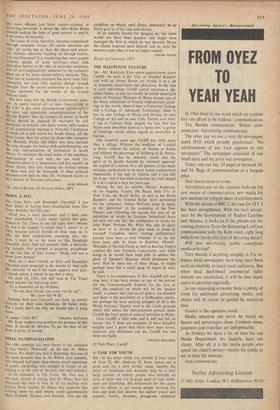THE HALFPENNY CULTURE SIR,—Mr. Keidrych Rhys seems apprehensive about Cardiff—he
dubs it the 'City of dreadful Knights' and with an almost Brutus cut brands it as a set of amateurs, materialists and philistines. In the face of such unkindness Cardiff cannot maintain a dig- nified silence—a city can hardly be called materialist when its National Museum of Wales houses one of the finest collections of French Impressionist paint- ings in the world, when it sites a University College and a College of Advanced Technology, when it has its own College of Music and Drama, its own College of Art and its own Civic Theatre and when it has in Cathays Park, despite the fact that Ian Nairn once described them as a 'stone zoo,' a group of buildings which others regard as unrivalled in Europe.
One hundred years ago Cardiff, was little more than a village. Without the tradition of Londori or Paris, without the culture of Vienna or Rome and without the patronage of Salzburg or St. Peters- burg, Cardiff has by industry, vision and the spirit of its people become by universal approval the capital of a nation. It is not perfect; it has made mistakes, particularly in its more recent architectural expressions; it has had its failures and it has still far to go—but it has tried to honour the trust placed in it as a capital a bare ten years ago.
During the last six months. Olivier, Redgrave, de los Angeles, Vasary, the Beaux Arts Trio of New York, the Royld Ballet, as well as the Ballet Rambert and the Festival Ballet, have performed for the 'amateurs.' Emlyn Williams came to speak to the 'philistines' at the reopening of the New Theatre and following the success last year of an exhibition of works by Graham Sutherland there are now ,not one but two exhibitions of works by John Piper. Perhaps Mr. Rhys was able to spare an hour or so during the past week to come to Llandaff Cathedral, where varying architectural periods have been so well blended—if so, he will have been able to listen to Katchen, Silvestri, Menuhin or Geraint Evans as well as hearing Tippett conduct his own Fantasia Concertante, and while doing so he would have been able to admire the glory of Epstein's Majestas which dominates the nave. Had he done any of these things, he might perhaps have felt a small pang of 'regret at what he said.
There is no complacency in this—Cardiff will not stop here; it has been chosen as one of the centres for the CommonWealth Festival for the Arts in 1965, the emphasis on which will be the 'spoken word'; a concert hall and an art gallery are planned and there is the possibility of a Gulbenkian centre; but perhaps the most exciting prospect of all is the Welsh National Theatre sited in the Castle grounds which will, unless the obstructionists prevail, make Cardiff the focal point of cultural activities in Wales.
Give Cardiff a little time and it will not fail its nation—but if these are examples of what dreadful knights (and I grant that there have been some), amateurs and philistines can do, Cardiff has not done too badly.
32 Park Place, Cardiff
LINCOLN HALLINAN


































 Previous page
Previous page